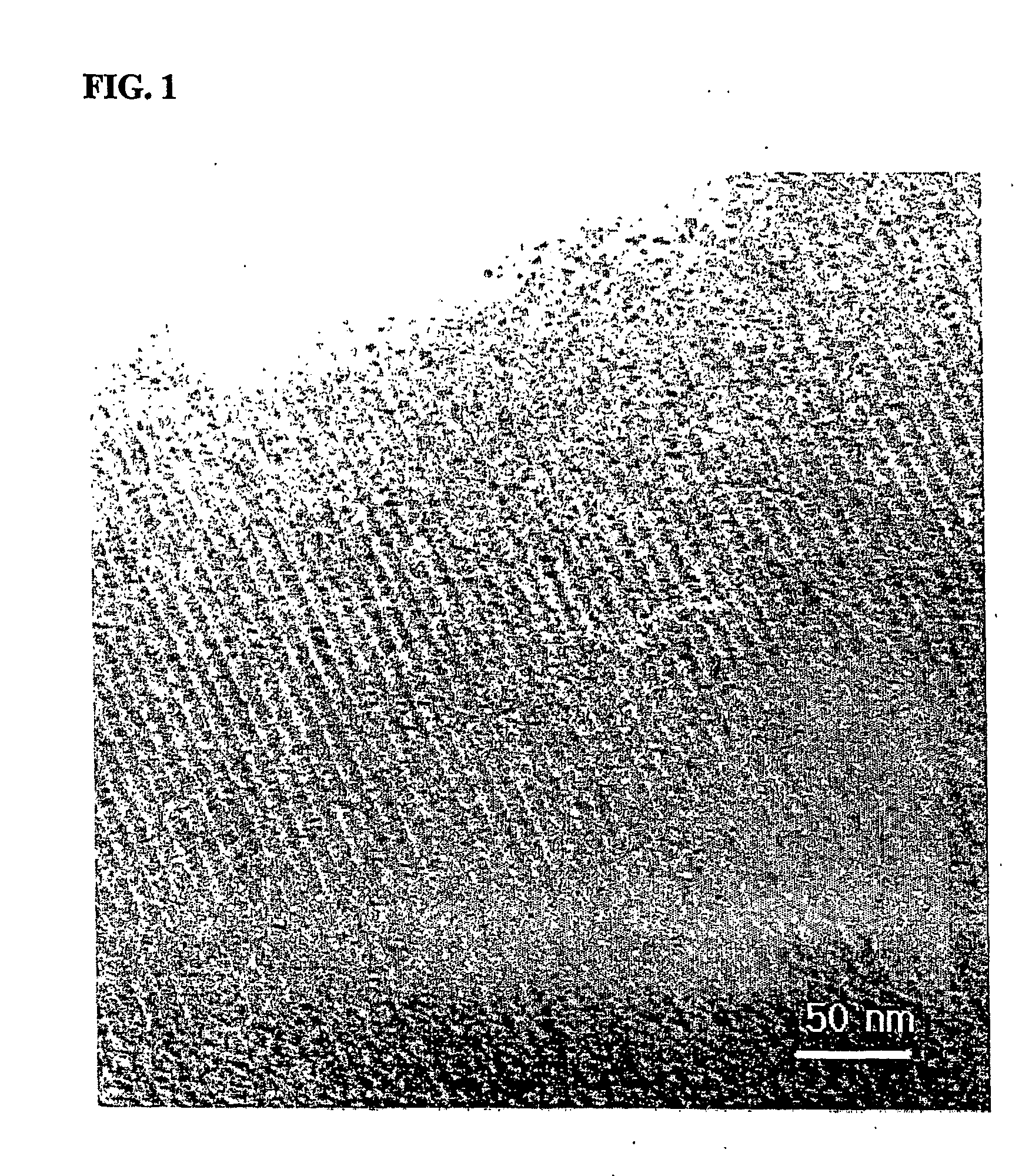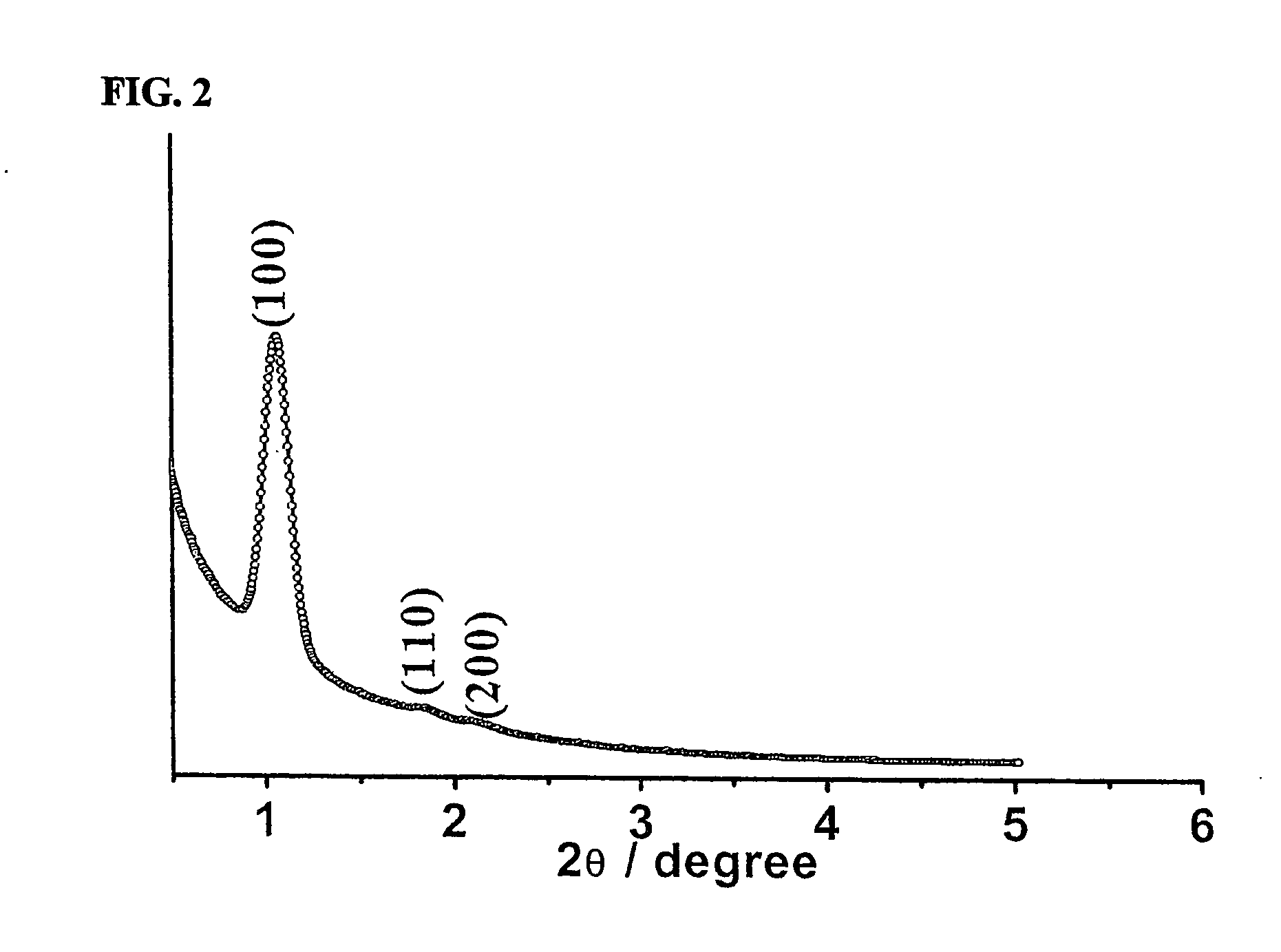Nano-structured metal-carbon composite for electrode catalyst of fuel cell and process for preparation thereof
a fuel cell and metal-carbon composite technology, applied in the direction of metal/metal-oxide/metal-hydroxide catalysts, cell components, physical/chemical process catalysts, etc., can solve the problem of deteriorating surface transmission characteristics of micro-pores, affecting the ability of catalysts to be bonded, and the size of metal crystals becomes larger
- Summary
- Abstract
- Description
- Claims
- Application Information
AI Technical Summary
Benefits of technology
Problems solved by technology
Method used
Image
Examples
example 1
A. Preparation of Nano Template (SBA-15)
[0039] Pre-heated 1.6M hydrochloric acid solution (380 mL) and surfactant Pluronic P123 (10 g) made by BASF Co., Ltd. were stirred and mixed at room temperature. Next, tetraethylorthosilicate (abbreviated as “TEOS”) (22 g) was added to the resultant mixture and stirred. Thereafter, TEOS was polymerized at 80° C. and the surfactant was removed, thereby obtaining SBA-15 as a nano template.
B. Preparation of Nano-Structured Pt—C Composite Using Nano Template
[0040] After the nano template (SBA-15) obtained from the preparation method A was calcined at 300° C., a Pt precursor solution was added to the nano template so that 30 wt % Pt based on the 1 g of the nano template was impregnated. The resultant mixture was dehydrated with a vacuum drier to impregnate Pt in the nano template. Here, (NH3)4Pt(NO3)2 was used as a Pt precursor. In the impregnation process, Pt precursor was induced to be introduced uniformly into the nano template by adding th...
example 2
A. Preparation of Nano Template (SBA-15)
[0041] The same procedure of Example 1 was repeated to obtain a nano template.
B. Preparation of Nano-Structured Pt—C Composite Using Nano Template
[0042] The same procedure of Example 1 was repeated except that 18 wt % Pt based on the 1 g of the nano template was impregnated, thereby obtaining a Pt—C composite of the present invention (Pt: C=24 wt %: 76 wt %).
example 3
A. Preparation of Nano Template (SBA-15)
[0043] The same procedure of Example 1 was repeated to obtain a nano template.
B. Preparation of Nano-Structured Pt—C Composite Using Nano Template
[0044] The same procedure of Example 1 was repeated except that 6 wt % Pt based on the 1 g of the nano template was impregnated, thereby obtaining a Pt—C composite of the present invention (Pt: C=12 wt %: 88 wt %).
PUM
| Property | Measurement | Unit |
|---|---|---|
| temperature | aaaaa | aaaaa |
| temperature | aaaaa | aaaaa |
| specific surface area | aaaaa | aaaaa |
Abstract
Description
Claims
Application Information
 Login to View More
Login to View More - R&D
- Intellectual Property
- Life Sciences
- Materials
- Tech Scout
- Unparalleled Data Quality
- Higher Quality Content
- 60% Fewer Hallucinations
Browse by: Latest US Patents, China's latest patents, Technical Efficacy Thesaurus, Application Domain, Technology Topic, Popular Technical Reports.
© 2025 PatSnap. All rights reserved.Legal|Privacy policy|Modern Slavery Act Transparency Statement|Sitemap|About US| Contact US: help@patsnap.com



